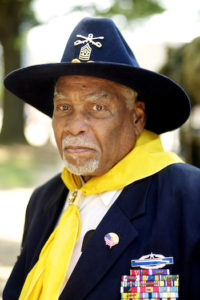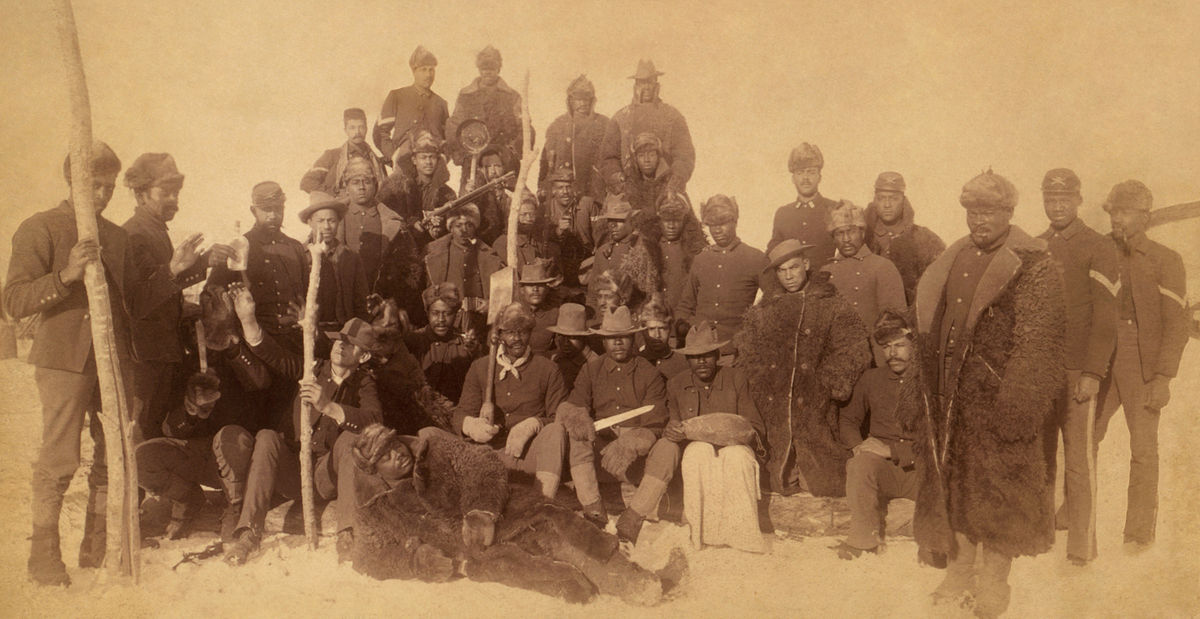In September 1867, Private John Randall of Troop G, US 10th Cavalry Regiment, was assigned to escort two civilians on a hunting trip. The hunter became the hunted when a band of 70 Cheyenne warriors swept down on the trio. The two civilians were killed in the initial attack and Randall’s horse shot out from under him.
 Cornered in a washout under some railroad tracks, single handed, Randall held off the attack with his revolver, despite a gunshot wound to his shoulder and no fewer than 11 lance wounds.
Cornered in a washout under some railroad tracks, single handed, Randall held off the attack with his revolver, despite a gunshot wound to his shoulder and no fewer than 11 lance wounds.
By the time help arrived, 13 Cheyenne warriors lay dead. Private Randall was still standing. Word spread among the Cheyenne about a new kind of soldier, “who had fought like a cornered buffalo; who like a buffalo had suffered wound after wound, yet had not died; and who like a buffalo had a thick and shaggy mane of hair.”
The US 10th Cavalry, formed on September 21, 1866 at Fort Leavenworth, Kansas, was the first unit of “Negro Cavalry”, an all-black unit which would soon be joined by the 9th, 24th and 25th Cavalry, and come to be known as “Buffalo Soldiers”.
Several all-black regiments were formed during the Civil War, including the 54th Massachusetts Volunteer Infantry depicted in the film, “Glory”. The “Buffalo Soldiers” were the first peacetime all-black regiments in the regular Army.
The original units fought in the American Indian Wars, the Spanish-American War, the Philippine-American War, the Border War and two World Wars, amassing 23 Medals of Honor by the end of 1918.

The old met with the new during WWII when Mark Matthews, veteran of the Pancho Villa Expedition, WW1, WW2 and the Battle of Saipan, was sent to train with the Tuskeegee Airmen. In the end, Matthews would prove too old to fly. A member of the Buffalo Soldiers Drum & Bugle Corps, Matthews would play taps at Arlington National Cemetery, always from the woods. Blacks of the era were not permitted at “white” funerals. 1st Sergeant Matthews retired shortly before the Buffalo Soldiers were disbanded, part of President Truman’s initiative to integrate United States’ armed forces..

In December 1944, the segregated 366th Infantry Regiment of the 92nd Infantry Division was fighting in the vicinity of Sommocolonia, in northern Italy. On Christmas day, German soldiers began to infiltrate the town, disguised as civilians. A heavy artillery barrage began in the early morning hours of the 26th, followed by an overwhelming attack of enemy ground forces. Vastly outnumbered, American infantry were forced to conduct a fighting retreat.
First Lieutenant John R. Fox, forward observer for the 598th Field Artillery Battalion, volunteered to stay behind with a small Italian force, to help slow the enemy advance. From the second floor of a house, Lieutenant Fox directed American defensive fire by radio, adjusting each salvo closer to his position. Warned that his final adjustment would bring down artillery fire on his own head, the soldier who received the message was stunned at the response. 1st Lt. John Fox’ last known words, were “Fire it.”
When American forces retook the town, Lieutenant Fox’ body was found with those of about 100 German soldiers.
The King James Bible translates John 15:13, as “Greater love hath no man than this, that a man lay down his life for his friends“. After the war, Sommocolonia erected a Memorial. A tribute to nine brave soldiers who gave their lives, that their brothers might live. Eight Italians, and one American.
In a January 13, 1997 ceremony at the White House, President Bill Clinton awarded the Medal of Honor, posthumously, to the family of 1st Lieutenant John R. Fox.
 1st Sergeant Mark Matthews, the last of the Buffalo Soldiers, died of pneumonia on September 6, 2005 at age of 111. A man who forged papers in order to join at age fifteen and once had to play taps from the woods, was buried with military honors at Arlington National Cemetery, section 69, grave #4215.
1st Sergeant Mark Matthews, the last of the Buffalo Soldiers, died of pneumonia on September 6, 2005 at age of 111. A man who forged papers in order to join at age fifteen and once had to play taps from the woods, was buried with military honors at Arlington National Cemetery, section 69, grave #4215.
An American Hero.
The rank of General of the Armies is equivalent to that of a six-star general, the highest possible operational rank of the United States Armed Forces. The rank has been awarded only twice, once posthumously to George Washington, and only once to an active-duty officer: John Joseph Pershing.
Then-1st Lieutenant Pershing served with the Buffalo Soldiers from October 1895 to May 1897 plus another six months in Cuba, and came to respect soldiers of African ancestry as “real soldiers”, in every way. As West Point instructor beginning in 1897, Pershing was looked down upon and insulted by white cadets and officers, aggrieved over Pershing’s strict and unyielding disciplinary policies.
The press sanitized the favored insult to “Black Jack,” delivered, no doubt, behind the man’s back, but that’s not they said.
During WW1, General Pershing bowed to the segregationist policies of President Woodrow Wilson and Secretary of War Newton Baker. It seems Pershing understood what the Connecticut academic and the Ohio politician had failed to learn, a principle the Reverend Martin Luther King Jr. would spell out, some fifty years later:
“We must learn to live together as brothers or perish together as fools”.



What incredibly brave men they were.
LikeLiked by 1 person
And to think that these men accomplished what they did at a time of real discrimination, based on the color of their skin.
LikeLiked by 1 person
It’s shocking really how badly they were treated by their counterparts, and yet they still gave their all. Remarkable!
LikeLiked by 1 person
Great post.
LikeLiked by 1 person
Thanks for coming along for the ride!
LikeLiked by 1 person
I save yours until later sometimes so I can concentrate… my pleasure.
LikeLiked by 1 person
Reblogged this on Dave Loves History.
LikeLiked by 1 person
Thanks for sharing, Dave.
LikeLiked by 1 person